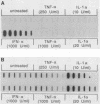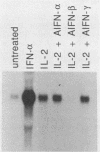Abstract
Accumulation of Mx gene products in cells of patients and experimental animals has been recognized as a useful marker for detecting minute quantities of biologically active interferon (IFN). Goetschy et al. (J. Goetschy, H. Zeller, J. Content, and M. A. Horisberger, J. Virol. 63:2616-2622, 1989) reported that not only IFNs but also interleukin-1 (IL-1) and tumor necrosis factor (TNF) were potent inducers of the human Mx genes. However, we observed no Mx induction in cultured human fibroblasts or in human peripheral blood mononuclear cells treated with various concentrations of IL-1 alpha or TNF-alpha. Mx induction was found in the spleens of mice treated with TNF-alpha or IL-1 alpha, but this effect could be neutralized with antibodies to murine IFN-alpha/beta. Of the other cytokines that we tested (IL-2, IL-6, and granulocyte-macrophage colony-stimulating factor), only IL-2 induced the Mx genes in peripheral blood mononuclear cells, but antibodies to human IFN-beta efficiently neutralized this effect. Our results thus indicate that IFNs are the only cytokines with intrinsic Mx-inducing activity.
Full text
PDF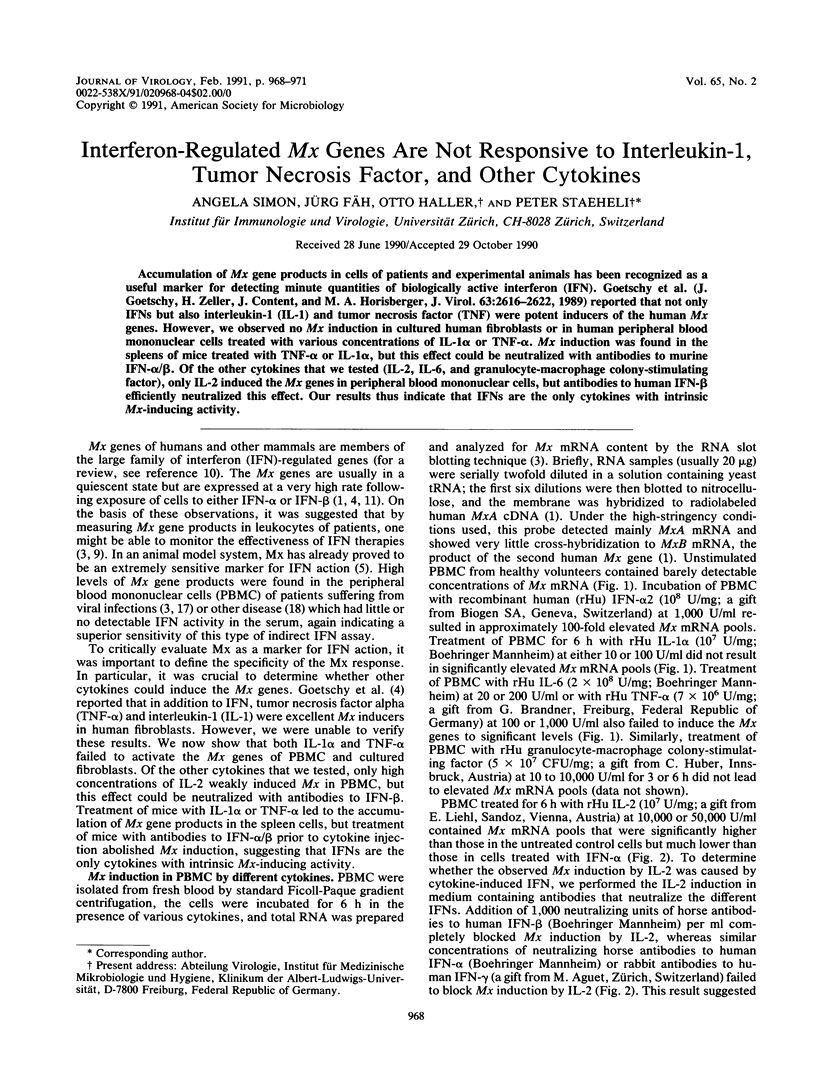
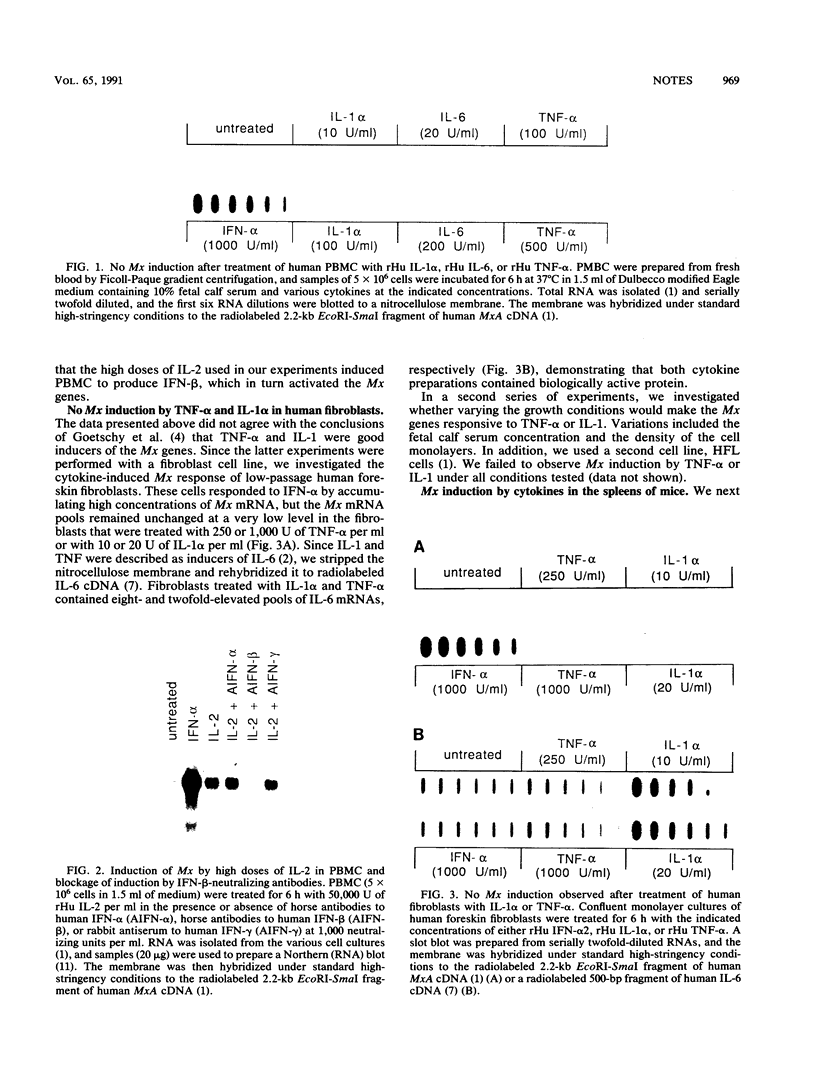
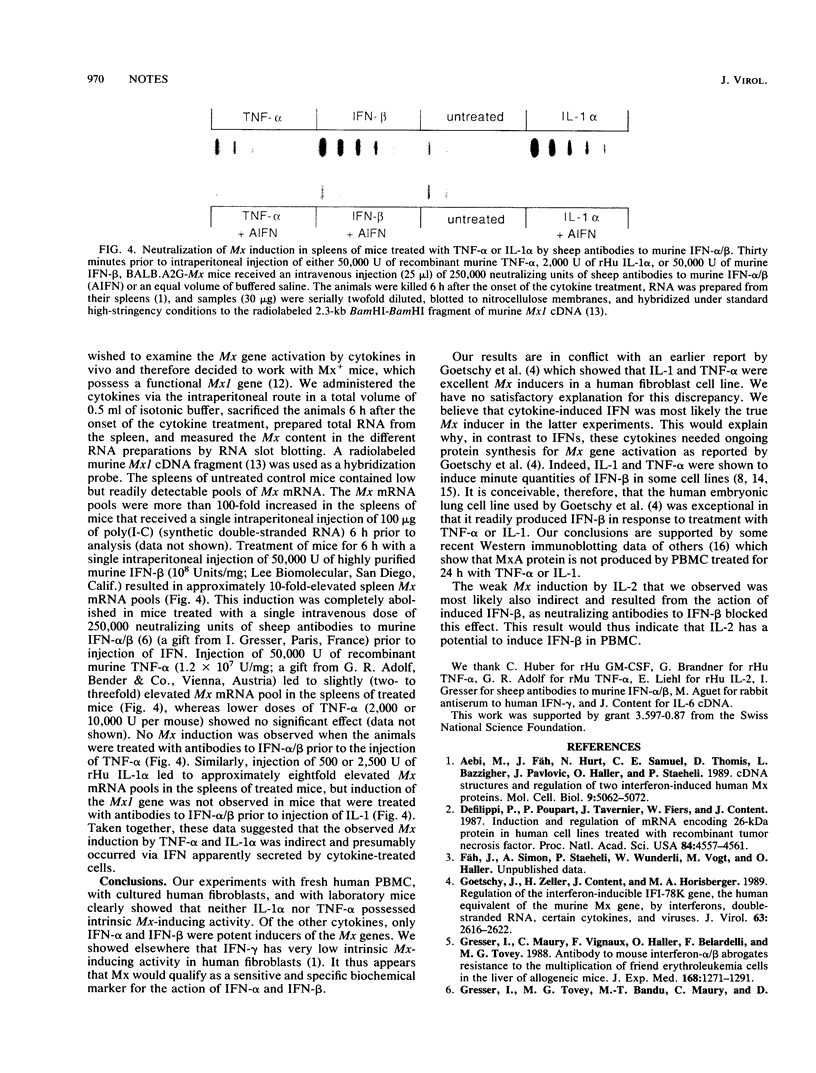
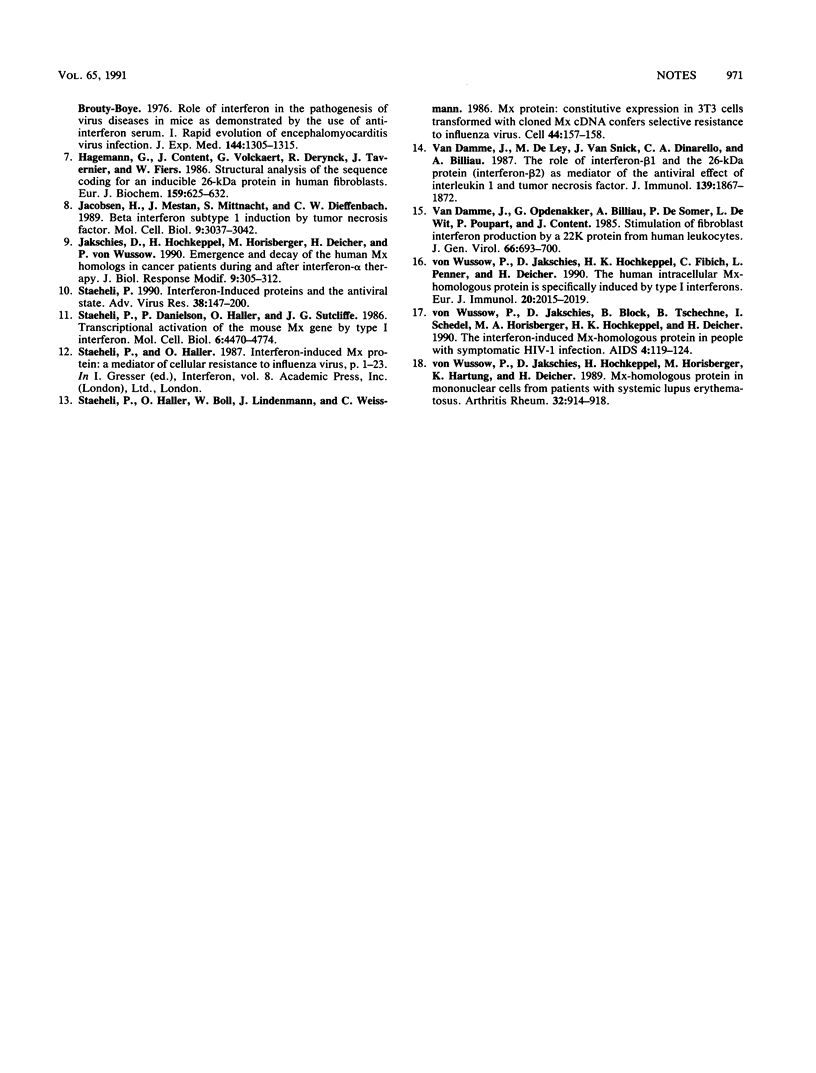
Images in this article
Selected References
These references are in PubMed. This may not be the complete list of references from this article.
- Aebi M., Fäh J., Hurt N., Samuel C. E., Thomis D., Bazzigher L., Pavlovic J., Haller O., Staeheli P. cDNA structures and regulation of two interferon-induced human Mx proteins. Mol Cell Biol. 1989 Nov;9(11):5062–5072. doi: 10.1128/mcb.9.11.5062. [DOI] [PMC free article] [PubMed] [Google Scholar]
- Defilippi P., Poupart P., Tavernier J., Fiers W., Content J. Induction and regulation of mRNA encoding 26-kDa protein in human cell lines treated with recombinant human tumor necrosis factor. Proc Natl Acad Sci U S A. 1987 Jul;84(13):4557–4561. doi: 10.1073/pnas.84.13.4557. [DOI] [PMC free article] [PubMed] [Google Scholar]
- Goetschy J. F., Zeller H., Content J., Horisberger M. A. Regulation of the interferon-inducible IFI-78K gene, the human equivalent of the murine Mx gene, by interferons, double-stranded RNA, certain cytokines, and viruses. J Virol. 1989 Jun;63(6):2616–2622. doi: 10.1128/jvi.63.6.2616-2622.1989. [DOI] [PMC free article] [PubMed] [Google Scholar]
- Gresser I., Maury C., Vignaux F., Haller O., Belardelli F., Tovey M. G. Antibody to mouse interferon alpha/beta abrogates resistance to the multiplication of Friend erythroleukemia cells in the livers of allogeneic mice. J Exp Med. 1988 Oct 1;168(4):1271–1291. doi: 10.1084/jem.168.4.1271. [DOI] [PMC free article] [PubMed] [Google Scholar]
- Gresser I., Tovey M. G., Bandu M. E., Maury C., Brouty-Boyé D. Role of interferon in the pathogenesis of virus diseases in mice as demonstrated by the use of anti-interferon serum. I. Rapid evolution of encephalomyocarditis virus infection. J Exp Med. 1976 Nov 2;144(5):1305–1315. doi: 10.1084/jem.144.5.1305. [DOI] [PMC free article] [PubMed] [Google Scholar]
- Haegeman G., Content J., Volckaert G., Derynck R., Tavernier J., Fiers W. Structural analysis of the sequence coding for an inducible 26-kDa protein in human fibroblasts. Eur J Biochem. 1986 Sep 15;159(3):625–632. doi: 10.1111/j.1432-1033.1986.tb09931.x. [DOI] [PubMed] [Google Scholar]
- Jacobsen H., Mestan J., Mittnacht S., Dieffenbach C. W. Beta interferon subtype 1 induction by tumor necrosis factor. Mol Cell Biol. 1989 Jul;9(7):3037–3042. doi: 10.1128/mcb.9.7.3037. [DOI] [PMC free article] [PubMed] [Google Scholar]
- Jakschies D., Hochkeppel H., Horisberger M., Deicher H., von Wussow P. Emergence and decay of the human Mx homolog in cancer patients during and after interferon-alpha therapy. J Biol Response Mod. 1990 Jun;9(3):305–312. [PubMed] [Google Scholar]
- Staeheli P., Danielson P., Haller O., Sutcliffe J. G. Transcriptional activation of the mouse Mx gene by type I interferon. Mol Cell Biol. 1986 Dec;6(12):4770–4774. doi: 10.1128/mcb.6.12.4770. [DOI] [PMC free article] [PubMed] [Google Scholar]
- Staeheli P., Haller O., Boll W., Lindenmann J., Weissmann C. Mx protein: constitutive expression in 3T3 cells transformed with cloned Mx cDNA confers selective resistance to influenza virus. Cell. 1986 Jan 17;44(1):147–158. doi: 10.1016/0092-8674(86)90493-9. [DOI] [PubMed] [Google Scholar]
- Staeheli P., Haller O. Interferon-induced Mx protein: a mediator of cellular resistance to influenza virus. Interferon. 1987;8:1–23. [PubMed] [Google Scholar]
- Staeheli P. Interferon-induced proteins and the antiviral state. Adv Virus Res. 1990;38:147–200. doi: 10.1016/s0065-3527(08)60862-3. [DOI] [PubMed] [Google Scholar]
- Van Damme J., De Ley M., Van Snick J., Dinarello C. A., Billiau A. The role of interferon-beta 1 and the 26-kDa protein (interferon-beta 2) as mediators of the antiviral effect of interleukin 1 and tumor necrosis factor. J Immunol. 1987 Sep 15;139(6):1867–1872. [PubMed] [Google Scholar]
- Van Damme J., Opdenakker G., Billiau A., De Somer P., De Wit L., Poupart P., Content J. Stimulation of fibroblast interferon production by a 22K protein from human leukocytes. J Gen Virol. 1985 Apr;66(Pt 4):693–700. doi: 10.1099/0022-1317-66-4-693. [DOI] [PubMed] [Google Scholar]
- von Wussow P., Jakschies D., Block B., Tschechne B., Schedel I., Horisberger M. A., Hochkeppel H. K., Deicher H. The interferon-induced Mx-homologous protein in people with symptomatic HIV-1 infection. AIDS. 1990 Feb;4(2):119–124. doi: 10.1097/00002030-199002000-00004. [DOI] [PubMed] [Google Scholar]
- von Wussow P., Jakschies D., Hochkeppel H. K., Fibich C., Penner L., Deicher H. The human intracellular Mx-homologous protein is specifically induced by type I interferons. Eur J Immunol. 1990 Sep;20(9):2015–2019. doi: 10.1002/eji.1830200920. [DOI] [PubMed] [Google Scholar]
- von Wussow P., Jakschies D., Hochkeppel H., Horisberger M., Hartung K., Deicher H. MX homologous protein in mononuclear cells from patients with systemic lupus erythematosus. Arthritis Rheum. 1989 Jul;32(7):914–918. [PubMed] [Google Scholar]




